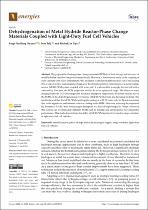| dc.contributor.author | Nyamsi, Serge Nyallang | |
| dc.contributor.author | Tolj, Ivan | |
| dc.contributor.author | Geca, Michał Jan | |
| dc.date.accessioned | 2022-09-14T10:08:28Z | |
| dc.date.available | 2022-09-14T10:08:28Z | |
| dc.date.issued | 2022 | |
| dc.identifier.citation | Nyamsi, S. N. et al. (2022). Dehydrogenation of metal hydride reactor-phase change materials coupled with light-duty fuel cell vehicles. Energies, 15(9),2982. https://doi.org/10.3390/en15092982 | en_US |
| dc.identifier.issn | 1996-1073 | |
| dc.identifier.uri | https://doi.org/10.3390/en15092982 | |
| dc.identifier.uri | http://hdl.handle.net/10566/7890 | |
| dc.description.abstract | The popularity of using phase change materials (PCMs) for heat storage and recovery of
metal hydrides’ reaction has grown tremendously. However, a fundamental study of the coupling of
such a system with a low-temperature PEM (polymer electrolyte membrane) fuel cell is still lacking.
This work presents a numerical investigation of the dehydrogenation performance of a metal hydride
reactor (MHR)-PCM system coupled with a fuel cell. It is shown that to supply the fuel cell with a
constant H2 flow rate, the PCM properties need to be in an optimized range. | en_US |
| dc.language.iso | en | en_US |
| dc.publisher | MDPI | en_US |
| dc.subject | Metal hydrides | en_US |
| dc.subject | Hydrogen | en_US |
| dc.subject | Fuel cell vehicles | en_US |
| dc.subject | Chemistry | en_US |
| dc.subject | South Africa | en_US |
| dc.title | Dehydrogenation of metal hydride reactor-phase change materials coupled with light-duty fuel cell vehicles | en_US |
| dc.type | Article | en_US |

